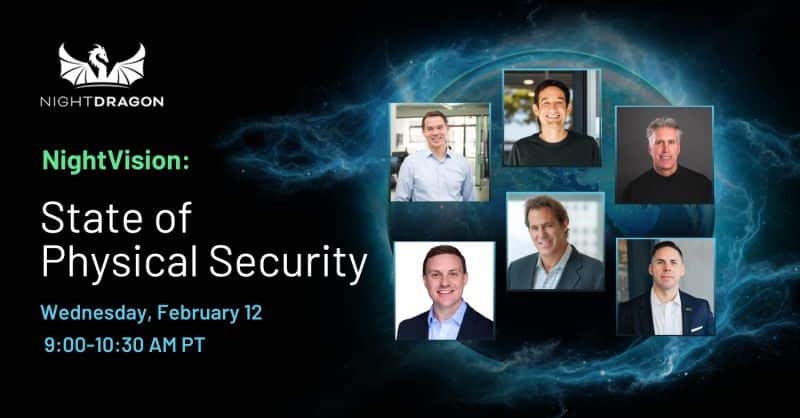The landscape of physical security is rapidly evolving as emerging threats and technological advancements reshape how organizations protect their people, assets, and infrastructure. NightDragon’s recent NightVision event brought together industry leaders to discuss the state of physical security in 2025.

The event builds on the recent NightDragon Market Report on Physical Security. To read the full report, click here.
In the NightVision event, security leaders and innovators highlighted the increasing convergence of cyber and physical security, the role of AI-driven solutions, and the need for organizations to rethink risk management. Below are ten key takeaways from the event that security professionals need to be aware of.
The Rising Threat Environment
From active shooter incidents to climate-driven disasters, physical threats are at an all-time high. NightDragon CEO Dave DeWalt noted that in 2024 alone, there were over 488 active shooter incidents in the U.S., along with severe wildfires and hurricanes disrupting businesses and communities. Organizations must incorporate comprehensive risk assessments and early warning systems to address these escalating threats.
The Cyber-Physical Convergence
Cyber threats are increasingly translating into physical consequences. GMI CSO Tim Roemer emphasized how ransomware attacks on critical infrastructure can impact essential services, while radicalization online can lead to real-world violence. Security teams must adopt an integrated approach to address both domains by leveraging AI-driven detection systems and cross-sector collaboration.
AI-Powered Threat Detection
Artificial intelligence is revolutionizing security operations. According to Dataminr CSO Rob Crowley, AI-driven video surveillance and social sentiment monitoring allow organizations to identify threats in real time, enabling faster responses. Companies like Dataminr use AI to detect and analyze public data, offering enterprises early warning signals to mitigate risks before they escalate.
The Importance of Visibility and Real-Time Awareness
A major challenge in security operations is the lack of real-time visibility. Michael Martin, CEO of RapidSOS, highlighted that organizations need tools providing instant insights into incidents, whether they stem from physical break-ins, cybersecurity breaches, or natural disasters. AI-enhanced emergency response solutions can bridge gaps between enterprises and public safety agencies to ensure faster and more effective intervention.
Enterprise Risk Management Must Evolve
Security has become a boardroom issue, requiring a structured risk assessment approach. Former Boeing CSO Dave Komendat stressed the importance of conducting regular risk assessments, updating security strategies frequently, and implementing penetration testing to ensure readiness against evolving threats. Establishing cross-functional security teams that include AI experts is key to adapting to new risks effectively.
The Expansion of Duty of Care
With employees working remotely or traveling more frequently, organizations must rethink how they protect their workforce. GMI’s Roemer pointed out that corporate security teams are now responsible for safeguarding employees across multiple locations, increasing the need for AI-driven intelligence and rapid communication tools. Automated monitoring and real-time alerts can provide a proactive layer of protection.
AI-Enhanced 911 and Emergency Response
Traditional 911 systems are outdated, but companies like RapidSOS are leveraging AI and cloud technology to revolutionize emergency response. RapidSOS’s Martin explained that their platform connects first responders with real-time data, improving response times and situational awareness for life-threatening incidents. These innovations are bridging the gap between corporate security teams and emergency services, reducing response times significantly.
Physical Security Technology is Scaling with AI
Surveillance systems are evolving from passive monitoring to proactive threat detection. Rhombus CEO Garrett Larson from Rhombus stated that AI-enabled cameras now detect anomalies, recognize faces and license plates, and integrate with emergency dispatch systems to automate security workflows. This technology ensures security teams can intervene quickly and efficiently.
Security is Now an Operational Resilience Strategy
Security leaders are no longer just protecting assets—they are ensuring business continuity. NightDragon’s DeWalt emphasized that organizations must embed security into their operational resilience strategies, using AI to predict, detect, and mitigate disruptions before they escalate into crises. This shift ensures that security is an integral part of corporate risk management frameworks.
AI’s Role in Automating Security Playbooks
The future of security lies in automation. GMI’s Roemer highlighted that by using AI-driven agentic playbooks, organizations can create predefined responses to incidents, reducing reliance on human intervention and increasing efficiency in crisis situations. AI-powered decision-making tools will continue to transform how security teams respond to threats dynamically.
To learn more about the state of the physical security market, please view our recent NightDragon Market Report on Physical Security. You can download that report for free here.
